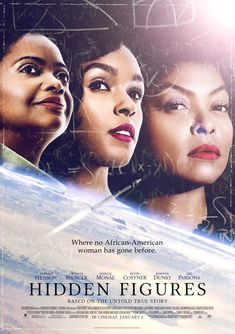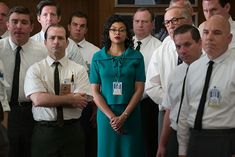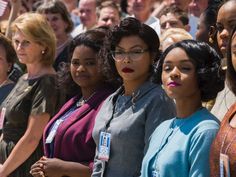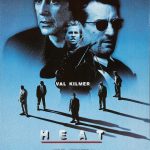Hidden Figures (2016)

Hidden Figures (2016)
Hidden Figures is a compelling and inspirational film that shines a long-overdue light on the untold stories of three remarkable African-American women whose work behind the scenes at NASA helped shape one of the most important moments in U.S. history: the launch of astronaut John Glenn into orbit. Directed by Theodore Melfi, this 2016 film combines the excitement of the space race with a powerful message about overcoming racial and gender barriers. With exceptional performances from Taraji P. Henson, Octavia Spencer, and Janelle Monáe, Hidden Figures is a story of courage, perseverance, and the triumph of the human spirit.

The film is set in the early 1960s, during the height of the Cold War and the space race between the United States and the Soviet Union. At NASA’s Langley Research Center in Virginia, three African-American women—Katherine Johnson (Taraji P. Henson), Dorothy Vaughan (Octavia Spencer), and Mary Jackson (Janelle Monáe)—work as “human computers,” performing complex calculations by hand. Despite their vital contributions to the space program, they face constant discrimination due to both their race and gender, navigating the segregated facilities and societal barriers of the time.
Katherine Johnson, a brilliant mathematician, is eventually assigned to the Space Task Group, where she works under the supervision of Al Harrison (Kevin Costner) to calculate the flight trajectories for NASA’s first manned missions. As the only woman—and the only Black woman—in the group, Katherine faces skepticism and prejudice from her colleagues, particularly Paul Stafford (Jim Parsons), but her mathematical genius quickly becomes indispensable.
Meanwhile, Dorothy Vaughan, who serves as the supervisor of the “Colored Computers” but has not been officially recognized or compensated for her role, teaches herself and her team how to program the IBM computer, anticipating the technological shift that will render human computers obsolete. Her determination and foresight not only secure her own position at NASA but also pave the way for future generations of Black women in technology.
Mary Jackson, the third of the trio, aspires to become NASA’s first female Black engineer. In a time when segregation laws prevent her from attending classes necessary to advance her career, she challenges the system by petitioning the court for the right to attend an all-white school, determined to break through the barriers that have kept her from reaching her full potential.
What makes Hidden Figures so captivating is the way it combines personal triumphs with larger historical moments. The film skillfully intertwines the personal struggles of these three women with the broader context of NASA’s race to beat the Soviets to space. Each woman’s story is an inspiring tale of resilience, highlighting how their intelligence, determination, and sheer willpower allowed them to rise above the obstacles they faced.
Taraji P. Henson delivers a powerful performance as Katherine Johnson, portraying her character with both vulnerability and quiet strength. Henson captures the frustration and isolation Katherine experiences as she navigates a predominantly white, male-dominated field, while also showcasing her brilliance as a mathematician. Katherine’s breakthrough moment—when she confidently writes the equation that will make John Glenn’s historic orbit possible—stands as one of the most triumphant scenes in the film.
Octavia Spencer, as Dorothy Vaughan, brings warmth and wisdom to her role, portraying a woman who refuses to be overlooked or underestimated. Spencer’s performance, filled with determination and grace, makes Dorothy a figure of quiet leadership, someone who is not only fighting for her own rights but also lifting others along the way. Janelle Monáe, as Mary Jackson, adds a fiery energy to the trio, portraying her character as a trailblazer who challenges both societal and institutional barriers with confidence and passion.
The film’s supporting cast, including Kevin Costner, Kirsten Dunst, and Mahershala Ali, provides depth to the narrative, showing the various ways that individuals within NASA either supported or resisted change during this transformative time in history. The dynamic between Katherine and Al Harrison (Costner), who grows to respect and rely on her, adds another layer of complexity to the film, illustrating how talent and persistence can eventually transcend prejudice.
Visually, Hidden Figures captures the look and feel of the 1960s with stunning period details, from the fashion to the workplace dynamics. The film’s pacing keeps the tension high, especially during the moments leading up to John Glenn’s launch, creating a sense of excitement and urgency that mirrors the real-life stakes of the space race.
At its core, Hidden Figures is not just a film about space exploration—it’s a film about breaking barriers, both literal and figurative. It’s a celebration of the unsung heroes whose contributions to history have often been overlooked, and a reminder that progress is driven by those who dare to challenge the status quo. The film’s message of equality and perseverance is timeless, making it an inspirational story for audiences of all backgrounds.

With its outstanding performances, engaging story, and powerful themes, Hidden Figures is a film that entertains, educates, and inspires. It’s a tribute to the brilliance and determination of three extraordinary women who proved that brains and courage can defy the odds and change the world.
SUGGESTED VIDEO FOR YOU: Survive 2024: Waking to a Dry Ocean – A Signal of the Coming Apocalypse










